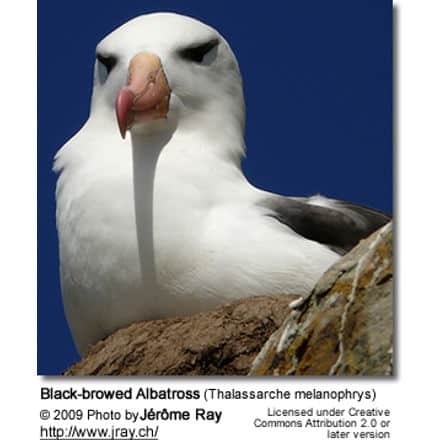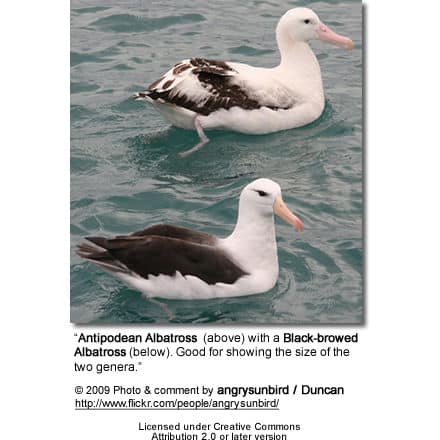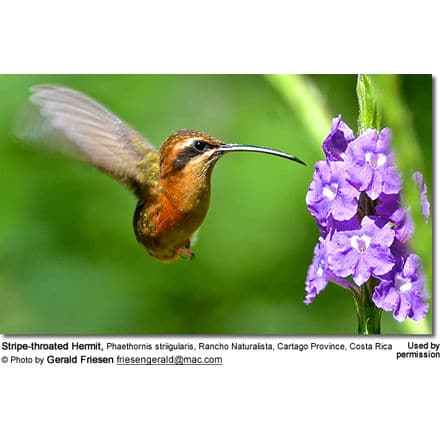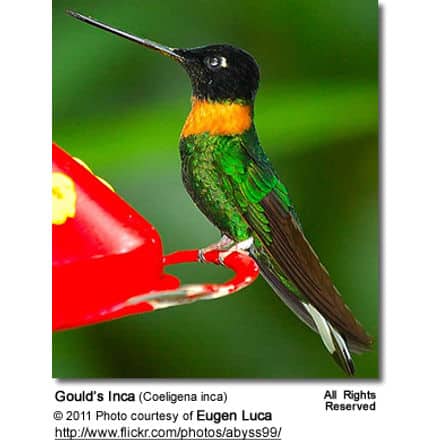Black-browed Albatrosses or Black-browed Mollymawkes
The Black-browed Albatrosses or Black-browed Mollymawk, Thalassarche melanophrys, is a large seabird of the albatross family Diomedeidae, and it is the most widespread and common albatross.

Description
The Black-browed Albatrosses are medium-sized albatross, 80–95 cm (31–37 in) long with a 200–240 cm (79–94 in) wingspan and an average weight of 2.9–4.7 kg (6.4–10 lb).
It has a dark grey saddle and upper wings that contrast with the white head, rump, and underparts. The underwing is predominantly white with broad, irregular, black margins.
It has a dark eyebrow and a yellow-orange bill with a darker reddish-orange tip.
Juveniles have dark horn-colored bills with dark tips, and a grey head and collar. They also have dark underwings. The features that identify it from other mollymawks are the dark eyestripe which gives it its name, a broad black edging to the white underside of its wings, a white head, and an orange bill, tipped darker orange.
They are similar to Grey-headed Albatrosses but the latter have wholly dark bills and more complete dark head markings.
They can have a natural lifespan of over 70 years.
| Location | Population | Date | Trend |
| Falkland Islands | 399,416 pair | 2007 | Decreasing 0.7% yr |
| South Georgia Island | 74,296 pair | 2006 | Decreasing |
| Chile | 122,000 pair | 2007 | |
| Antipodes Island | ??? pair | 1998 | |
| Campbell Island | ??? pair | 1998 | |
| Heard Island | 600 pair | 1998 | Increasing |
| McDonald Island | ??? pair | 1998 | |
| Crozet Islands | ??? pair | 1998 | |
| Kerguelen Islands | ??? pair | 1998 | Decreasing |
| Macquarie Island | ??? pair | 1998 | |
| Snares Islands | ??? pair | 1998 | |
| Total | 150,000 | 2005 | Decreasing |
Range and Habitat
The Black-browed Albatrosses is circumpolar in the southern oceans, and it breeds on 12 islands throughout the southern oceans.
In the Atlantic Ocean, it breeds on the Falklands, Islas Diego Ramírez, and South Georgia. In the Pacific Ocean, it breeds on Islas Ildefonso, Diego De Almagro, Isla Evangelistas, Campbell Island, Antipodes Islands, Snares Islands, and Macquarie Island.
Finally, in the Indian Ocean, it breeds on the Crozet Islands, Kerguelen Islands, Heard Island, and McDonald Island.
There are an estimated 1,220,000 birds alive with 600,853 breeding pairs, as estimated by a 2005 count. Of these birds, 402,571 breeds in the Falklands, 72,102 breeds on South Georgia Island, and 120,171 breed on the Chilean islands of Islas Ildefonso, Diego De Almagro, Isla Evangelistas, and Islas Diego Ramírez. 600 pairs breed on Heard Island, Finally, the remaining 5,409 pairs breed on the remaining islands.
This particular species of albatross prefers to forage over shelf and shelf-break areas.
Falkland Island birds winter near the Patagonian Shelf, and birds from South Georgia forage in South African waters, using the Benguela Current, and the Chilean birds forage over the Patagonian Shelf, the Chilean Shelf, and even make it as far as New Zealand.
It is the most likely albatross to be found in the North Atlantic due to a northerly migratory tendency.
There have been 20 possible sightings in the Continental United States.
Behavior
Colonies are very noisy as they bray to mark their territory, and also cackle harshly. They use their fanned tail in courting displays.
Feeding
The Black-browed Albatrosses feeds on fish, squid, crustacea, carrion, and fishery discards. This species has been observed stealing food from other species.
Reproduction
This species normally nests on steep slopes covered with tussock grass and sometimes on cliffs; however, on the Falklands it nests on flat grassland on the coast. They are an annual breeder laying one egg between 20 September and 1 November, although the Falklands, Crozet, and Kerguelen breeders lay about 3 weeks earlier.
Incubation is done by both sexes and lasts 68 to 71 days.
After hatching, the chicks take 120 to 130 days to fledge. Juveniles will return to the colony after 2 to 3 years but only to practice courtship rituals, as they will start breeding around the 10th year.

Conservation
the IUCN classifies this species as Endangered due to a drastic reduction in population. Bird Island near South Georgia Island had a 4% per year loss of nesting pairs, and the Kerguelen Island population had a 17% reduction from 1979 to 1995.
Diego Ramírez decreased in the 1980s but has rebounded recently, and the Falklands had a surge in the 1980s[13][23] probably due to abundant fish waste from trawlers; however, recent censuses have shown a drastic reduction in the majority of the nesting sites there.
Between all the ups and downs, the overall situation is grim, with a 67% decline over 64 years.
Increased longline fishing in the southern oceans, especially around the Patagonian Shelf and around South Georgia has been attributed as a major cause of the decline of this bird, In fact, the Black-browed Albatrosses are the most common bird killed by fisheries. Not to be left out trawl fishing, especially around the Patagonian Shelf and near South Africa, is also a large reason.
Conservation efforts underway start with this species being placed on the Convention on Migratory Species Appendix II, and Agreement on the Conservation of Albatrosses and Petrels Annex 1, it is being monitored on half of the islands, and most of the breeding sites are reserves.
Heard Island, McDonald Island, Macquarie Island, and the New Zealand islands are World Heritage Sites. Finally, an initial Chilean census has been completed.
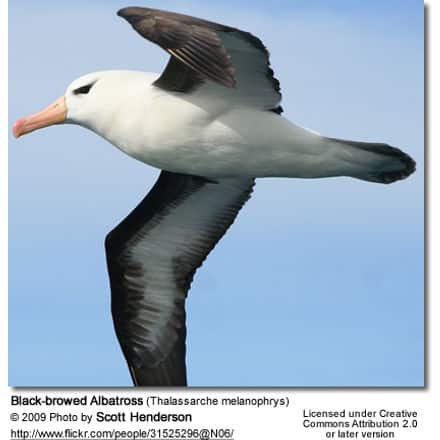
Noteworthy
Although this is a rare occurrence, on several occasions a Black-browed Albatross has summered in Scottish Gannet colonies (Bass Rock, Hermaness, and now Sula Sgeir) for a number of years.
Ornithologists believe that it was the same bird, known as Albert, who lives in north Scotland. It is believed that the bird was blown off course into the North Atlantic over 40 years ago, and it is suspected that the bird is over 47 years old.
A similar incident took place in the gannet colony in the Faroe Islands island of Mykines, where a Black-browed Albatross lived among the gannets for over 30 years. This incident is the reason why an albatross is referred to as a ‘Gannet King’ (Faroese: súlukongur) in Faroese.
Taxonomy
Mollymawks are a type of Albatross that belongs to the Diomedeidae family and come from the Procellariiformes order, along with Shearwaters, Fulmars, Storm-petrels, and Diving-petrels. They share certain identifying features.
First, they have nasal passages that attach to the upper bill called naricorns. Although the nostrils on the Albatross are on the sides of the bill. The bills of Procellariiformes are also unique in that they are split into between 7 and 9 horny plates.
Finally, they produce a stomach oil made up of wax esters and triglycerides that are stored in the proventriculus (stomach). This is used against predators as well as an energy-rich food source for chicks and for adults during their long flights.
They also have a salt gland that is situated above the nasal passage and helps desalinate their bodies, due to the high amount of ocean water that they imbibe. It excretes a high saline solution from their nose.
In 1998, Robertson and Nunn published the need for the Campbell Albatross, Thalassacre melanphrys, to be split from this species. Over the course of the next few years more experts agreed, starting with BirdLife International in 2000, and Brooke in 2004. James Clements has not agreed yet, neither has ACAP, and SACC recognizes the need for a proposal.
The Black-browed Albatross was first described as Diomedea melanophris by Coenraad Jacob Temminck, in 1828, based on a specimen from Cape of Good Hope.
Etymology
The origin of name melanophrus comes from two Greek words; melas or melanos meaning black, and ophrus which means the eyebrow. This, of course, is referring to the black plumage around its eyes.
Beauty Of Birds strives to maintain accurate and up-to-date information; however, mistakes do happen. If you would like to correct or update any of the information, please contact us. THANK YOU!!!

